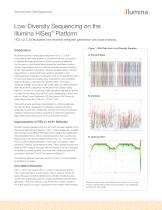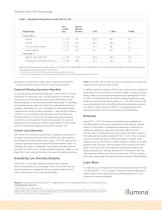
Catalog excerpts

Technical Note: DNA Sequencing lllumina HiSeq® Platform HCS v2.2.38 facilitates low-diversity template generation and data analysis. Nucleotide diversity—having equal proportions of A, C, G, and T nucleotides at each base position in a sequencing library—is required for effective template generation on lllumina sequencing platforms. For this reason, most lllumina library preparation workflows include a random fragmentation step to create the necessary sequence diversity at each base position in the library. Libraries generated without random fragmentation, or produced through amplicon generation, have traditionally been challenging to sequence. Data from these libraries tend to have lower yields and quality scores compared to more nucleotide- balanced libraries constructed from genomic DNA. To increase nucleotide diversity and produce high-quality data, low-diversity libraries often require library preparation modifications that include pooling together a number of uniquely bar-coded samples (multiplexing), spiking in a high-diversity library such as PhiX, and/or designating a control lane with the HiSeq Control Software (HCS). See Using a PhiX Control for HiSeq Sequencing Runs (Pub. No. 770-2011-041). This technical note describes improvements to HCS that eliminate the need for library preparation modifications and the need for a designated control lane. Additionally, results from the lllumina internal validation testing are provided, supporting a method for generating high-quality performance scores from low-diversity libraries. Improvements in RTAvl .18.61 Software Recently, lllumina released HCS v2.2.38, which includes updates to the real-time analysis (RTA) software v1.18.61. These updates are modeled after changes to the MiSeq®RTA March 2013 release that significantly improved performance with low-diversity samples. See Low-Diversity Sequencing on the lllumina MiSeq Platform (Pub. No. 770-2013-013). HCS v2.2.38 includes optimization of the color normalization matrix estimation, phasing, and prephasing rates. These updates improve the ability of RTA to analyze samples with low diversity such as in amplicon or bisulfite converted samples, and those with unbalanced genomic composition such as AT- or GC-rich genomes (Figure 1). The following features have been added to HCS v2.2.38 and applied Color Matrix Estimation RTA v1.18.61 now uses the first 11 cycles of sequencing data for color matrix estimation, and the same matrix is used to correct all reads. Because nucleotide distribution is critically important during the first few sequencing cycles for cluster identification and template generation, HCS will continue to use the first four cycles of data (or five in the case of v4 runs) to calculate the color matrix. After template Figure 1: SAV Data from Low-Diversity Samples Standard quality metrics generated from an internal run of a single amplicon sample demonstrate improved ability to call unbalanced samples with high quality.
Open the catalog to page 1
Technical Note: DNA Sequencing Table 1: Standard Quality Metrics with HCS v2.2.38 Sample Type Cluster Densityb (K/mm²) Internal Constant Basesa Single Amplicon Illumina internal sequencing runs using HCS v2.2.38 with both TruSeq® SBS v3 and HiSeq SBS v4 chemistries demonstrate that low-diversity samples yield high-quality scores with a spike-in of 10% PhiX. a. Diverse library with internal five base-pair monosequence after nine cycles. b. For optimal cluster densities, see Denaturing and Diluting Libraries for the HiSeq and GAIIx (part #15050107). generation is complete, the initial matrix...
Open the catalog to page 2All Illumina catalogs and technical brochures
-
iSeq 100
12 Pages
-
NextSeq™ 550Dx Instrument
4 Pages
-
NextSeq 500 System
12 Pages
-
Nextseq series
12 Pages
-
MiniSeq System
4 Pages
-
Miseq system application
8 Pages
-
HiSeq X Series
4 Pages
-
NextSeq 500
4 Pages
-
HiScan ® and iScan Systems
4 Pages















